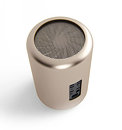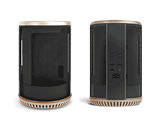Tuesday, March 8th 2016
Dune Case is the Mac Pro Lookalike That Everyone Can Have
Dune Case is a premium small form-factor PC case that should instantly remind you of the latest Apple Mac Pro, but packing whatever hardware (or software) you wish it had, in its 260 mm x 215 mm x 215 mm dimensions. Its designer is raising $130,000 on Kickstarter to get it to the shelves, and has already raised half the amount, with 8 days of fundraising to go. You can back the project from this page. The aluminium-built case comes in rose gold and black.
Unlike the Mac Pro, which features a cylindrical design with key components arranged along three sides of a triangular structure, with cooling machinery taking up its center; the Dune Case takes a different approach. It's spit into three compartments vertically along the bore of the cylinder, with the center holding a mini-ITX motherboard, one side with room for a full-height yet under 185 mm graphics card (connected to the motherboard through a PCIe riser); and the third compartment holding two 2.5-inch drives. A custom rear panel plugs into your motherboard, and an SFX power supply (not included) fuels your build. The main air channel is a 140 mm spinner that spouts warm air from the top.
Unlike the Mac Pro, which features a cylindrical design with key components arranged along three sides of a triangular structure, with cooling machinery taking up its center; the Dune Case takes a different approach. It's spit into three compartments vertically along the bore of the cylinder, with the center holding a mini-ITX motherboard, one side with room for a full-height yet under 185 mm graphics card (connected to the motherboard through a PCIe riser); and the third compartment holding two 2.5-inch drives. A custom rear panel plugs into your motherboard, and an SFX power supply (not included) fuels your build. The main air channel is a 140 mm spinner that spouts warm air from the top.




68 Comments on Dune Case is the Mac Pro Lookalike That Everyone Can Have
I built hackintoshes for people that just had to have OSX. They never used it and I ended up wiping it years later. Dual booting to win7 was just better (and that's sad).
anybody know can i put my 750 evga in to that ?
and there isnot any issue about tempture , the top caps made with full aluminum and there is so cold because the fresh air sucked from the bottom side to the top side , and 140mm fan pull up the hot air to the out.
the direction is just to the top . the psu section ( bottom side ) is spilted to the two section and mainboards air is not mixed to the GPU section. bottom of the mainboard and GPU is mesh ! so they always breath fresh air !
both of the GPU and mainbaord part have fresh air from the bottom side and the bottom side is mesh .
hope i solved your issue .
and fresh air is came from the bottom side
and here is panels view.
and here is how the case breathing :)
please look at the mesh at the bottom side of the mainboard :)
Not bad TBF. I suppose the fact that it is a straight through the heatsink type system gives it an edge on many of the more conventional SFX cases. It is almost the same effect as water cooling, since you are forcing the airflow through the heatsink and immediately out of the case, like what you would do with a radiator. Laptops are quite similar actually... You'd be surprised how much power you can get rid of with a tiny heatsink if you are feeding it with fresh air...
I think the design of the fan on the Mac Pro is pretty good, it's basically a large radius centrifugal fan, means it doesn't need to run at stupid RPMs like a laptop fan, but has the noise advantage due to the much smaller blade separation and almost no blade-tip noise. IIRC they also spent a lot of effort in reducing the bearing noise.
- Lack of internal expansion - you have to add whatever you need using USB and Thunderbolt. That's just asking for a mess of cables that many users would prefer to hide inside their case.
- Going off the previous point, you only get one small SSD for internal storage, so external drives (and cables to them) will almost definitely happen.
- GPUs are weaker than desktop equivalents (D300 = underclocked 7870, D500 = cut down and underclocked 7950, D700 = underclocked 7970). And for both gaming and compute, one strong GPU is easier to work with than two weaker ones.
- GPUs can't be upgraded. Since GPUs tend to get outdated faster than the rest of the system (CPUs tend to remain relevant for quite a while), I consider that a big minus.
- From the Anandtech review, rather high temperatures under load. I would not want my GPU hanging out in the upper 80s range. And having the CPU above 90 C means there's not much room left before throttling.
That said, they did an excellent job with controlling noise with a small case, which is always a challenge.The card probably won't die, but it would still make me uncomfortable because higher temperatures mean less headroom for higher ambient temperatures or dust. And I'm not sure where the 110-120 C figure you got comes from. Even the second-gen 290/290x cards don't hit 110-120 C and throttle way before they get there (around 95 C it looks like).
(edit, grammar)
But I feel like Nvidia sets the default limit to 80/84 C (depending on the card) before dropping boost clocks for a reason. We don't know exactly why (it could be because leakage/power consumption goes way too high at higher temperatures), but one possibility is that reliability or lifespan takes a hit. Otherwise, they could just let it get hotter and advertise higher performance with lower fan speeds.
Going back to the Mac Pro, I'd still rather not see GPU temperatures in the high 80s right out of the box. Dust and/or higher ambient temperatures will only make it go higher. And going back to this dune case, I hope there's enough airflow for the graphics card. Open cooler cards might have a difficult time and end up re-using their own hot exhaust.
Furthermore, the cards I've seen have a default fan curve that does not exceed a certain speed no matter what, unless you manually set the fan speed through overclocking software. They throttle or drop boost clocks once the target maximum temperature is reached. For the Mac Pro, according to the Anandtech review the maximum fan speed (and there is only one case fan that cools every component) is just below 2000 RPM. Even when components throttle (as shown in the stress test), the fan does not run faster.
So unless the GPUs in the Mac Pro have a very high throttle point, I'd be worried about dropping performance due to thermal constraints if cooling capability is hampered by dust or high ambient temperatures. And if the throttle point is very high (>90 C), I'd be concerned about component lifespan. Other Tahiti and Pitcairn chips do not get anywhere near as hot.
As to component lifespan, not really much to worry about. As was quoted before, these components are technically capable of running around 100C. I have a 280 that still works that ran around 87c it's whole life just because something was messed up with the contact on the cooler. Basically max temps and throttle points are set for any given amount of extended time but if it's not 24/7 the lifespan of the card isn't really reduced unless something happens physically. Considering the chips in the Mac Pro are AFAIK mobile chips they're designed, built, and meant to run hot for a long time just like laptops.
In the case of the OP case at hand, the cooling solutions on AIB cards going into that slot are way better than the setup that's designed in the Mac Pro and laptops. Just something to think about.
The contact on the cooler issue is an example of what I'd be concerned about with temperatures going so high. Metal expands slightly when heated, and contracts again when cooled. That could cause issues with contact, and over time metal fatigue could result in more serious issues (i.e. cracks). That's why you'd want a low difference between idle and load temperatures.
I don't think the Mac Pro chips are mobile chips, at least from looking at Techpowerup's GPU database. The desktop HD 7870 and Mac Pro D300 are both listed as Pitcairn, while the mobile 7970M (which has a similar core config) is listed as Wimbledon. Similarly the D500 and D700 are listed as Tahiti, which is what the desktop 7970/7950 are called.
But then I have doubts about the database's accuracy too. The D500 is clocked lower than the 7950 and has a more cut down core configuration, but has a TDP of 274 W - 74 W higher than the 7950's 200 W TDP. How does that make sense? I doubt that 20 MHz higher memory clock on the D500 is responsible for an over 74 W power increase. The 7870 XT has a similar core configuration (compared to the D500), but has an even lower TDP of 185 W.
I agree that AIB cooling solutions will be better in a large case with good airflow - my doubt is with whether the conditions in the Dune case will play well with open cooler cards.
As to the heat expanding the metal, not much really to worry about. I have cards that have lasted a long time overclocked without issue, even ones with dinky little heatsinks. I think you're overthinking the issue there in regards to all that. I mean sure the technicality of it is true, but these pieces are made to last a long time. In regards to the thermal properties and the capabilities, it's just known through the tech community. If you think about it, laptop chips have a higher TJMax because they have much smaller coolers to expel all that heat. Desktop chips are configured to throttle at lower temperatures but they can take the same amount of heat before any real damage occurs. So back to overthinking it, hardware is overdesigned and you really have to push a ton of volts and overclock to seriously degrade the life of hardware. Even then, it's not by much unless you physically damage the piece. I have an i5 750 that I ran at -48c 24/7 for about 6 months pushing 1.6v through and it's still kicking like I did nothing to it. Same goes for much older pieces I overclocked like my Pentium 1 and 2. If you stick to stock clocks and keep your hardware cleaned on a regular basis without any extras happening (like a PSU dying throwing every volts out) you shouldn't have anything to worry about.
I really don't think heat would be a problem for aftermarket cooled cards. I think if anything the heat from the CPU would be more of a concern than the GPU, but that's just my opinion based on the design drawings.
Hardware usually has generous tolerances and Mac Pro GPUs will keep working even at very high temperatures. I had a laptop where the CPU regularly went to 99 C and throttled, because HP laptop cooling is hilariously poor, and it never died. But I'm still not impressed by the Mac Pro's cooling. The AMD 7950 stock blower with the default fan curve will keep the card at or below 80-81 C. Similarly, enthusiast CPU coolers will keep >100 W CPUs below 90 C.